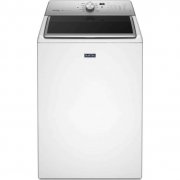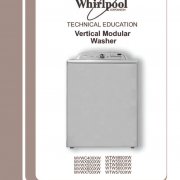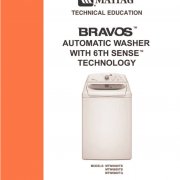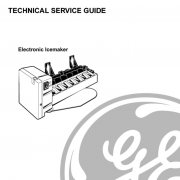Refrigerator Repair
Troubleshooting Refrigerator Problems
If you don’t know what’s wrong with your refrigerator, how can you expect to fix your refrigerator? Is the freezer cold enough, but the fresh food compartment warming? If there is a noise, is it coming from inside the freezer, behind the refrigerator, or somewhere else? Is there frost forming anywhere out of the ordinary? Take a moment to observe your refrigerators symptoms, it will be well worth your time.
Good Observation Skills Are The Key To Any Successful Refrigerator Repair!
Note: The sealed system of a refrigerator or freezer must be repaired by a licensed professional. It is almost never cost effective to do so out of the warranty period. Important: do not use an ice pick or anything else to remove ice! Any cut or puncture in the sealed system tubing and you will be shopping for a new refrigerator!! Use warm water in a turkey baster if you are in a hurry.
What’s Your Refrigerator’s Problem?
- “Freezer compartment is not cold enough.”
- “The freezer is okay but the fresh food area of the refrigerator is warming up.”
- “The freezer AND fresh food areas
are not as cold as they should be.” - “There’s a lot of frost in the freezer
or moisture in the fresh food area.” - “I’m getting a large amount of frost in my ice dispenser shoot”.
- “There is a sheet of ice on the floor of my freezer compartment”.
- “I have water under my crispers or dripping
into the refrigerator’s fresh food compartment.” - “Water is leaking onto my floor.”
- “There is a noise in my freezer.”
- “There is a noise coming from behind my refrigerator.”
Other Refrigerator Help Topics…
Freezer compartment is not cold enough.
Question:
Is the back wall of the freezer cold?
Yes:
Do you hear the evaporator fan running or feel air flowing from the rear vents in the freezer? If not you probably are having a problem with the refrigerators evaporator fan. If you do hear the fan and feel air flowing from the freezer vents, you will need to check the evaporator for an even frost pattern and your refrigerator’s compressor. More
No:
You will need to pull the refrigerator away from the wall and check the compressor (usually located behind a cardboard or metal panel behind the refrigerator.) More
The freezer temperature is OK but the fresh food compartment of the refrigerator is warming up.
All of the cold generated by a refrigerator comes from the freezer compartment and flows into the fresh food compartment, so most likely you are having an air flow problem. The fan located in the freezer compartment is called the evaporator fan. It is responsible for moving the cool air from the freezer compartment into the fresh food compartment of the refrigerator through a controlled duct called the diffuser. The diffuser is located at the back top center of the fresh food compartment.
Question:
Do you hear the evaporator fan running or feel air flowing from the rear vents in the freezer?
Yes
No
Freezer Temp is Okay But The Refrigerator Is Not Cold Enough
All of the cold generated by most refrigerators comes from the freezer compartment and flows into the fresh food compartment, so most likely you are having an air flow problem. The fan located in the freezer compartment is called the evaporator fan. It is responsible for moving the cool air from the freezer compartment into the fresh food compartment of the refrigerator through a controlled duct called the diffuser. The diffuser is located at the back top center of the fresh food compartment.
Question:
Do you hear the evaporator fan running or feel air flowing from the rear vents in the freezer?
Yes:
Do you feel air passing through the diffuser into the fresh food compartment? Sometimes the diffuser duct can become clogged with ice and not allow air to pass through. (This is most often caused by a door being left open for an extended period of time or a defrost problem) In some rare cases a door inside the diffuser can break in the closed position and block airflow. More
No:
The evaporator fan will cycle on and off depending on temperature and the defrost cycle, so if you don’t hear anything wait for 20 minutes and check again. If you still don’t hear anything or you hear a strange humming noise you probably need a new evaporator fan motor. Some refrigerators will cycle the fan off when you open the door so your ears won’t be inconvenienced when your hunting for some yummy yums, so listen close…More
There’s a lot of frost in the freezer or moisture in the fresh food compartment.
The refrigerator / freezer should automatically go through a defrost cycle to control frost build up; however, if a door is left open for a long period of time a larger than average amount of moisture can enter the refrigerator / freezer and condense into water or frost. (High humidity can magnify this effect) You will also want to inspect the door seal for any tearing or debris that might allow air to leak in.
Tip:
Tilt the refrigerator / freezer back slightly by adjusting the front leveling legs so the doors will swing closed automatically with gravity. In most cases storing your food elsewhere temporarily, unplugging the refrigerator and allowing it to defrost will usually solve this problem, especially if you know the door was left open.
(Use caution with wood flooring, the larger than normal amount of ice will sometimes cause the drip pan to overflow onto the floor.) If you notice the problem returning in about three days to a week and you know the door was not left open you may have a problem with the defrost cycle. More
Note:
These symptoms may also cause your fresh food compartment to warm up if the air diffuser becomes blocked with ice.
I’m getting a large amount of frost in my ice dispenser shoot.
The ice dispenser of you refrigerator obviously needs to open in order to allow ice to fall into your glass for a nice cool drink; however, it is equally important that it close again. The small door that automatically opens and closes within your dispenser is called a damper door and it is lined with a material that seats against the ice shoot and creates an airtight seal. If the damper door material becomes misshapen or dirty it may not seal completely and allow moist air to enter into the freezer compartment. When this moist air-cools it condenses into frost, this is no only inconvenient it can also cause airflow problems and cooling issues. Inspect the damper door for anything that may allow air to leak through.
Refrigerator Repair: A sheet of ice on the floor of your freezer!
A sheet of ice in the freezer compartment is caused by a blocked defrost drain. You may even notice water dripping into the refrigerator compartment from time to time. In most cases storing your food elsewhere temporarily, unplugging the refrigerator and allowing it to defrost will usually solve this problem. (Use caution with wood flooring, the larger than normal amount of ice will sometimes cause the drip pan to overflow onto the floor.) Before you plug the unit back in carefully remove the back wall of the freezer compartment and remove any food or plastic particles that my clog the small hole at the base of the evaporator coils.(Silver tubing) If the problem persists you may need to add a drain heater. More
I have water under my crispers or dripping into the refrigerator’s fresh food compartment.
This problem is caused by a blocked defrost drain. Carefully remove the back wall of the freezer compartment and remove any food or plastic particles that my clog the small hole at the base of the evaporator coils. (Silver tubing) Sometimes a large amount of ice can build up from a defrost problem and block the drain. In most cases storing your food elsewhere temporarily, unplugging the refrigerator and allowing it to defrost will usually solve this problem. (Use caution with wood flooring, the larger than normal amount of ice will sometimes cause the drip pan to overflow onto the floor.) If the problem persists you may need to add a drain heater. More
There is a noise in my freezer.
Question:
Is it a buzzing noise, or does it sound like a sizzle? A sizzling noise in normal during a defrost cycle and should stop in a few minutes when the refrigerator cycles back on.
A buzzing noise could be your evaporator fan having a problem or hitting on an ice build up as it spins. Use caution!! A buzzing sound can also be electrical arcing and pose a shock hazard. Be sure to unplug the refrigerator before you proceed with your investigation.
There is a noise coming from behind my refrigerator.
Some times compressors can become noisy as they get older but this is usually a gradual process. If a new sound has reared its ugly head the most likely culprit is the “condenser fan”. This fan is located next to the compressor and moves air across the compressor and condenser coils to cool them.
Unplug the unit, remove the back cover and inspect the fan to see if anything might be to close allowing the fan to hit as it rotates. (Such as insulation, wiring or a rodent. Use caution and repair any cut wiring.)
The freezer and fresh food compartment are not as cold as they should be.
Question:
Is there any frost on the back wall of the freezer?
Yes
You may have a defrost problem. If the evaporator coil behind the back wall of the freezer is frozen to a point that air can no longer pass through it then the freezer and fresh food compartments will begin to warm up due to restricted air flow.
No
Unfortunately this is a dreaded symptom. If the compressor is running, you can hear the fan inside the freezer area working, and the unit is not placed in an extremely hot or cold environment (a hot or cold garage for example) then you may want to go shopping. However, if the compressor is not running troubleshoot the compressor start relay. More
Water is leaking onto my floor!
If your temperatures appear to be normal this can be a tricky problem; the best way to solve it is to get your flashlight and a kneepad and start watching. If the problem is constant it is probably related to your water supply to the ice maker or water dispenser; however, if it seems to be on a schedule it is probable related to the ice maker system or the defrost cycle. Possible sources: ice makers, water valve, ice maker water supply line, filter housing, cracked drip pan, defrost drain tube missing the drip pan, or a clogged defrost drain. More
The defrost cycle
The defrost cycle is what makes a frost-free refrigerator/freezer frost-free, and this is how it works… As the sealed system pulls heat from the refrigerator, frost builds up on the evaporator coils behind the back panel of the freezer compartment. A timer, appropriately named “the defrost timer” keeps track of how many hours the compressor has been running. (The compressor will cycle on and off to keep a particular temperature.) After approximately 8 to 10 hours of run time the defrost timer will signal a defrost cycle to start. The defrost timer will stop power to the compressor and evaporator fan and reroute it to a thermostat called a “bi-metal thermostat” which will be “closed” (Allowing electricity to flow through) when it is cold. From there the electricity flows through a heater called the “defrost heater” located at the bottom of the evaporator coil. The heater melts the ice that has developed from the moisture in the air condensing and freezing on the very cold evaporator coils. It is common to hear a “hissing” or “sizzling” sound in the freezer compartment during the defrost cycle. As the ice melts, the water is directed down a drain below the evaporator where it is channeled through some tubing to a pain called a “drip pan” near the warm compressor or condenser coils (black coils underneath the refrigerator) so the air can absorb it once again. Defrost cycle times usually last between 15 to 30 minutes. More
Checking the compressor and start relay
This information is provided as a service to you! Please view the safety disclaimer page and safety page before proceeding. The compressor can get very hot, the condenser fan is sharp, and water and electricity can make a dangerous cocktail! If at any point you don’t feel comfortable you should stop and call a professional appliance repair person for help. If the compressor is vibrating and your freezer compartment is not cold enough, try cleaning any dust that may be blocking air from moving freely across the black coils located underneath or behind the refrigerator. These condenser coils and are used to release the heat that has been removed from inside the refrigerator into the room. Many refrigerators also use a condenser fan near the compressor to help move air across the condenser coils. If the condenser coils are clean and the condenser fan is working(if your refrigerator has one) it is probably time to go shopping for that new refrigerator you’ve always wanted. However, if the compressor is not vibrating you may have a power supply problem. Set your voltmeter to measure 120 volts AC and check for power at the relay terminals, if no power is measured you may have a problem with your cold control thermostat, if correct voltage is measured check the relay Unplug the refrigerator. Look for a small unit attached to the compressor with 2 or 3 wires plugged into it; this is the “start relay” Draw a little map reminding you what color wires go where, and then remove the start relay. Take your voltmeter and check each of the three compressor terminals to the frame or a ground wire for continuity, if you get a reading its time to buy a new refrigerator. If not go to the next step. If you shake the start relay and you hear what sounds like sand inside, it might be worth the gamble to replace the relay. (That’s the nice part about hiring a pro, they have spare parts to gamble with.)





Very useful article, thank you very much for this post! I always try to find specialists with high qualifications and experience, so lately I use the services of euappliancerepair.com